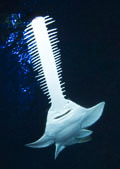|
|
|
SHARK INFO |
|
SHARK |
|
SHARK EVOLUTION |
|
|
|
SHARK DIVING |
|
SHARK DIVING 101 |
|
|
|
CONSERVATION |
|
|
|
PHOTOGRAPHY |
|
SHARK PHOTO TIPS |
|
|
|
RESOURCES |
|
|
|
WEB STUFF |
|
WHAT IS ELASMODIVER? Not just a huge collection of Shark Pictures: Elasmodiver.com contains images of sharks, skates, rays, and a few chimaera's from around the world. Elasmodiver began as a simple web based shark field guide to help divers find the best places to encounter the different species of sharks and rays that live in shallow water but it has slowly evolved into a much larger project containing information on all aspects of shark diving and shark photography. There are now more than 10,000 shark pictures and sections on shark evolution, biology, and conservation. There is a large library of reviewed shark books, a constantly updated shark taxonomy page, a monster list of shark links, and deeper in the site there are numerous articles and stories about shark encounters. Elasmodiver is now so difficult to check for updates, that new information and pictures are listed on an Elasmodiver Updates Page that can be accessed here:
|
|
_ |
Stingray Barb Pictures |
|
Pictures of Stingray Barbs from various species of stingrays
|
|
Steve Irwin’s sad death has generated hundreds of emails to Elasmodiver requesting information about stingrays and stingray barbs. Rather than try to answer them all individually I have created this page that covers most of the questions that people have been asking:
Stingrays need protecting! Since the tragic incident with Steve Irwin there have been reports of reprisals against stingrays involving fishermen cutting off their tails and leaving them to die. Not only is this practice barbaric, if it gets out of control it will upset the balance of the environment. Stingrays are very vulnerable because they reproduce slowly and have much fewer offspring than bony fishes. Stingrays (like sharks) play an important role in keeping the numbers of invertebrate animals in check. If the rays are wiped out from a particular area the entire localized ecosystem will begin to change. Imagine what a plague of snails could do to a reef if there were no stingrays to keep their numbers down. Stingrays have a right to defend themselves but they are generally gentle and timid. They are extremely graceful creatures that appear to ‘fly’ through the water like giant birds and the world would be a lesser place without them.
For more information on Stingrays visit the following pages: |



























